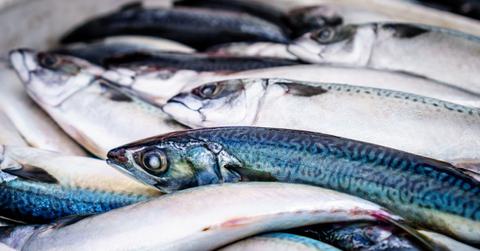This Company Found A Way For Carbon Dioxide To Help Overfishing
In an effort to find a way to feed farmed fish more efficiently, one startup has turned to an unlikely source: carbon dioxide.
Updated May 26 2019, 1:56 p.m. ET
As the world's hunger for seafood grows, the ocean's fish population is dwindling. More than 85 percent of the world's fisheries have been pushed to or beyond their biological limits due to overfishing – the process by which more fish are caught than the population can replace through natural reproduction – and several important commercial fish populations (such as Atlantic bluefin tuna) have declined to the point where their survival as a species is threatened.
One response to this crisis has been the growth of aquaculture production, or farming fish instead of catching them in the wild. The use of aquaculture production has more than doubled in the last 17 years, and while this can help preserve some wild species, there's still one problem: feeding farmed fish requires catching smaller fish from the ocean. In other words, the growth of aquaculture has only worked to exacerbate the problem.
In an effort to find a way to feed farmed fish more efficiently, one startup has turned to an unlikely source: carbon dioxide.
How it work is NovoNutrients, collects untreated carbon dioxide and other emissions from various industrial sources and pipes it into their plant. The pollution then feeds microbes that are similar to the ones that live near gas vents in the ocean, and the microbes become an alternate source of protein for companies that make fish food pellets and typically use small fish caught in the ocean. The company is also tapping synthetic biology to produce nutrients like vitamins and probiotics to be added to the feed.
“About 36 billion tons [of CO2] a year are emitted globally, and we are not aware of other economically feasible large-scale carbon utilization practices,” David Tze, CEO of NovoNutrients, told Fast Company. “We’re sure others will emerge over time, but we think it will be interesting to be in that first batch to be commercialized.”
The process of creating these microbe and nutrients happens in pipes that help the captured gases dissolve in water. The pipes connect directly to the industrial emitter, pushing all the would-be atmospheric pollution into a neighboring factory next door, which is where the fish food is made. To make it even more green, the whole system can be powered by hydrogen.
A bonus to this process that may help make it more widely accepted is that it could be cheaper than catching fish to turn into fishmeal. For one, some companies will pay to have their gases captured, whereas fishing only costs money. Additionally, the demand from aquaculture has made fishmeal expensive, particularly when you add nutrients like probiotics. NovoNutrients' process could make this more affordable.
While there are other startups attempting to solve the overfishing and fishmeal problem, the fact that NovoNutrients doubles as an emissions reduction system makes it attractive. However, there is only so much they can do to eliminate climate pollution.
“Unfortunately, 36 billion tons of emissions of CO2 a year is a lot, and it’s going to require more than just addressing the protein needs of animal feed to solve that,” Tze told Fast Company. “We hope to be a small but important part of the solution, but we certainly would not claim to be even a plurality of the solution.”
